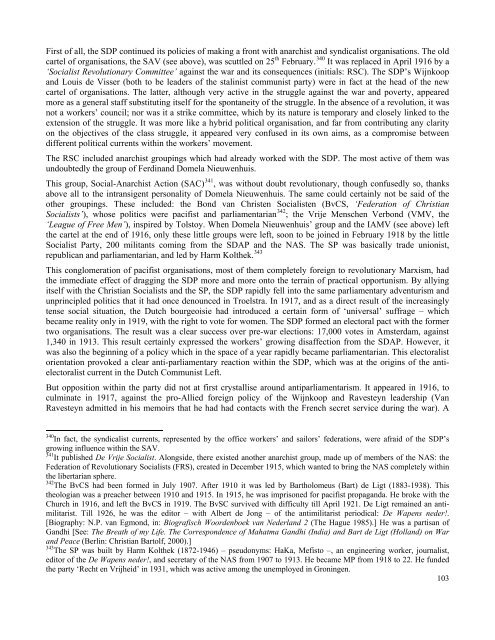The German-Dutch Communist Left - Libcom
The German-Dutch Communist Left - Libcom
The German-Dutch Communist Left - Libcom
Create successful ePaper yourself
Turn your PDF publications into a flip-book with our unique Google optimized e-Paper software.
First of all, the SDP continued its policies of making a front with anarchist and syndicalist organisations. <strong>The</strong> old<br />
cartel of organisations, the SAV (see above), was scuttled on 25 th February. 340 It was replaced in April 1916 by a<br />
‘Socialist Revolutionary Committee’ against the war and its consequences (initials: RSC). <strong>The</strong> SDP’s Wijnkoop<br />
and Louis de Visser (both to be leaders of the stalinist communist party) were in fact at the head of the new<br />
cartel of organisations. <strong>The</strong> latter, although very active in the struggle against the war and poverty, appeared<br />
more as a general staff substituting itself for the spontaneity of the struggle. In the absence of a revolution, it was<br />
not a workers’ council; nor was it a strike committee, which by its nature is temporary and closely linked to the<br />
extension of the struggle. It was more like a hybrid political organisation, and far from contributing any clarity<br />
on the objectives of the class struggle, it appeared very confused in its own aims, as a compromise between<br />
different political currents within the workers’ movement.<br />
<strong>The</strong> RSC included anarchist groupings which had already worked with the SDP. <strong>The</strong> most active of them was<br />
undoubtedly the group of Ferdinand Domela Nieuwenhuis.<br />
This group, Social-Anarchist Action (SAC) 341 , was without doubt revolutionary, though confusedly so, thanks<br />
above all to the intransigent personality of Domela Nieuwenhuis. <strong>The</strong> same could certainly not be said of the<br />
other groupings. <strong>The</strong>se included: the Bond van Christen Socialisten (BvCS, ‘Federation of Christian<br />
Socialists’), whose politics were pacifist and parliamentarian 342 ; the Vrije Menschen Verbond (VMV, the<br />
‘League of Free Men’), inspired by Tolstoy. When Domela Nieuwenhuis’ group and the IAMV (see above) left<br />
the cartel at the end of 1916, only these little groups were left, soon to be joined in February 1918 by the little<br />
Socialist Party, 200 militants coming from the SDAP and the NAS. <strong>The</strong> SP was basically trade unionist,<br />
republican and parliamentarian, and led by Harm Kolthek. 343<br />
This conglomeration of pacifist organisations, most of them completely foreign to revolutionary Marxism, had<br />
the immediate effect of dragging the SDP more and more onto the terrain of practical opportunism. By allying<br />
itself with the Christian Socialists and the SP, the SDP rapidly fell into the same parliamentary adventurism and<br />
unprincipled politics that it had once denounced in Troelstra. In 1917, and as a direct result of the increasingly<br />
tense social situation, the <strong>Dutch</strong> bourgeoisie had introduced a certain form of ‘universal’ suffrage – which<br />
became reality only in 1919, with the right to vote for women. <strong>The</strong> SDP formed an electoral pact with the former<br />
two organisations. <strong>The</strong> result was a clear success over pre-war elections: 17,000 votes in Amsterdam, against<br />
1,340 in 1913. This result certainly expressed the workers’ growing disaffection from the SDAP. However, it<br />
was also the beginning of a policy which in the space of a year rapidly became parliamentarian. This electoralist<br />
orientation provoked a clear anti-parliamentary reaction within the SDP, which was at the origins of the antielectoralist<br />
current in the <strong>Dutch</strong> <strong>Communist</strong> <strong>Left</strong>.<br />
But opposition within the party did not at first crystallise around antiparliamentarism. It appeared in 1916, to<br />
culminate in 1917, against the pro-Allied foreign policy of the Wijnkoop and Ravesteyn leadership (Van<br />
Ravesteyn admitted in his memoirs that he had had contacts with the French secret service during the war). A<br />
340 In fact, the syndicalist currents, represented by the office workers’ and sailors’ federations, were afraid of the SDP’s<br />
growing influence within the SAV.<br />
341 It published De Vrije Socialist. Alongside, there existed another anarchist group, made up of members of the NAS: the<br />
Federation of Revolutionary Socialists (FRS), created in December 1915, which wanted to bring the NAS completely within<br />
the libertarian sphere.<br />
342 <strong>The</strong> BvCS had been formed in July 1907. After 1910 it was led by Bartholomeus (Bart) de Ligt (1883-1938). This<br />
theologian was a preacher between 1910 and 1915. In 1915, he was imprisoned for pacifist propaganda. He broke with the<br />
Church in 1916, and left the BvCS in 1919. <strong>The</strong> BvSC survived with difficulty till April 1921. De Ligt remained an antimilitarist.<br />
Till 1926, he was the editor – with Albert de Jong – of the antimilitarist periodical: De Wapens neder!.<br />
[Biography: N.P. van Egmond, in: Biografisch Woordenboek van Nederland 2 (<strong>The</strong> Hague 1985).] He was a partisan of<br />
Gandhi [See: <strong>The</strong> Breath of my Life. <strong>The</strong> Correspondence of Mahatma Gandhi (India) and Bart de Ligt (Holland) on War<br />
and Peace (Berlin: Christian Bartolf, 2000).]<br />
343 <strong>The</strong> SP was built by Harm Kolthek (1872-1946) – pseudonyms: HaKa, Mefisto –, an engineering worker, journalist,<br />
editor of the De Wapens neder!, and secretary of the NAS from 1907 to 1913. He became MP from 1918 to 22. He funded<br />
the party ‘Recht en Vrijheid’ in 1931, which was active among the unemployed in Groningen.<br />
103
















